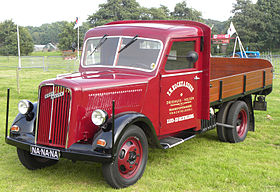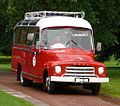
Opel Automobile GmbH, usually shortened to Opel, is a German automobile manufacturer which has been a subsidiary of Stellantis since 16 January 2021. It was owned by the American automaker General Motors from 1929 until 2017 and the PSA Group prior to its merger with Fiat Chrysler Automobiles to form Stellantis in 2021. Most of the Opel lineup is marketed under the Vauxhall Motors brand in the United Kingdom since the 1980s. Some Opel vehicles were badge-engineered in Australia under the Holden brand until 2020, in North America and China under the Buick, Saturn, and Cadillac brands, and in South America under the Chevrolet brand.

The Mercedes-Benz Sprinter is a light commercial vehicle (van) built by Mercedes-Benz Group AG of Stuttgart, Germany as a large van, chassis cab, minibus, and pickup truck. In the past, the Sprinter had been sold under the Mercedes-Benz, Dodge, and Freightliner nameplates. In the U.S., it was built from complete knock down (CKD) kits by Freightliner. Re-badged and re-engined Sprinters were also sold by Volkswagen Commercial Vehicles as the Volkswagen LT and the Volkswagen Crafter. They are now primarily marketed by Mercedes-Benz.

The Opel Olympia is a compact car by German automaker Opel, then part of G.M., from 1935 to 1940, and after World War II continued from 1947 to 1953. It was one of the world's first mass-produced cars with a unitary body structure, after the 1934 Citroën Traction Avant; and it was a mass-production success, made in six-figure numbers. Opel achieved this even before the war, all while Hitler promised Germany a "Volkswagen" - a 'People's car', which didn't materialize until 1946. From 1967-1970 the Olympia badge was briefly reused on a later car.
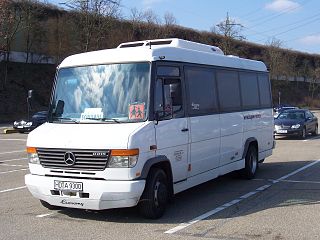
The Mercedes-Benz Vario is a full-size commercial heavy van and medium duty truck manufactured by Mercedes-Benz between 1996 and 2013.
Bedford Vehicles, usually shortened to just Bedford, was a brand of vehicle manufactured by Vauxhall Motors, then a subsidiary of multinational corporation General Motors. Established in April 1931, Bedford Vehicles was set up to build commercial vehicles. The company was a leading international lorry brand, with substantial export sales of light, medium, and heavy lorries throughout the world.
The Mercedes-Benz MB100 is a light commercial cabover van (M) made by Mercedes-Benz España S.A. from 1981 to 1996 at their Vitoria-Gasteiz factory in northern Spain. The third generation model was manufactured by SsangYong alongside the rebadged SsangYong version from 1995 to December 2003 in South Korea, with another rebadged variant manufactured by Maxus of SAIC Motor from 2009 to 2014 in China.
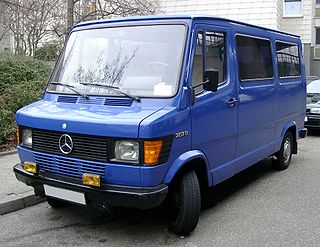
In 1977 Mercedes-Benz introduced a new van/truck, called T1 internally. Other designations were series TN / T1N and Bremer Transporter, since the vehicle was built in the Transporter-Plant in Bremen, Germany, first. In the years 1983/1984 production went - piece by piece - to the Transporter-Plant-Düsseldorf. The internal chassis-designations are: 601, 602 and 611.

Ludwigsfelde is a town in the north of the district Teltow-Fläming in Brandenburg.
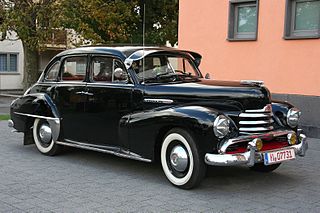
The Opel Kapitän is a luxury car made in several different generations by the German car manufacturer Opel from 1938 until 1970.

ENASA was a Spanish motor vehicle manufacturing company that was incorporated in 1946 after having bought the automotive assets of the Spanish Hispano-Suiza and the Italian Fiat in Spain. It produced trucks, buses and military armored vehicles under the Pegaso and, for a short while, Sava brands. ENASA belonged to INI, a Spanish state-owned industrial holding company.

The Volkswagen Crafter, introduced in 2006, is the largest three- to five-ton van produced and sold by the German automaker Volkswagen Commercial Vehicles. The Crafter officially replaced the Volkswagen Transporter LT that was launched in 1975, although it is known as the LT3, its production plant code.
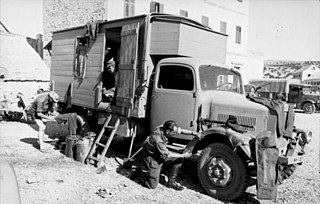
The Mercedes-Benz L3000 was a 4x2 3-tonne rear axle drive truck used by Nazi Germany in World War II, powered by a Daimler-Benz OM 65/4 74 hp 4-cylinder diesel engine. It was used alongside the Opel Blitz, and proved even more reliable in rough terrain; and was used in all fronts and extensively by the Afrika Korps. It was manufactured in three versions, the L3000, the L3000A, and the L3000S, from 1938 to 1944. When production was discontinued, more than 27,700 L3000 type trucks had been built, making it the most produced Mercedes-Benz truck of World War II.
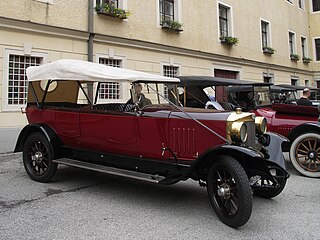
Steyr was an Austrian automotive brand, established in 1915 as a branch of the Österreichische Waffenfabriks-Gesellschaft (ÖWG) weapon manufacturing company. Renamed Steyr-Werke AG in 1926 and merged with Austro-Daimler and Puch into Steyr-Daimler-Puch AG, it continued manufacturing Steyr automobiles until 1959.

The Bedford CF is a range of full-size panel vans produced by Bedford. The van was introduced in 1969 to replace the CA model, and was sized to compete directly with the Ford Transit, which had entered production four years earlier. Its design was similar to its American counterpart, the Chevrolet Van (1971–1995).

The automotive industry in Germany is one of the largest employers in the world, with a labor force of over 857,336 (2016) working in the industry.

The Opelwerk Brandenburg was a truck vehicle assembly plant, located in Brandenburg an der Havel, Germany. Built within seven months, it was opened by Adam Opel AG in November 1935 on the re-armament initiative of the Nazi government in order to ensure supplies of Opel Blitz trucks for the Wehrmacht armed forces. By 1944 more than 130,000 medium-weight trucks had been produced at the Brandenburg plant. Devastated by an Allied air raid on 6 August 1944, the facilities were dismantled and shipped east as reparations to the Soviet Union after the war.

The Mercedes-Benz L 319 is a light commercial vehicle built by Mercedes-Benz between 1955 and 1967. Larger than a standard delivery van, but smaller than a conventional light truck of the period, it was the manufacturer's first model in this class. The vehicle was offered with a range of van and truck bodies. Special application and minibus variants were also available.
Hanns Grewenig was a German engineer who pursued a successful career in the German Automobile Industry. He was the Commercial Director and a leading member of the executive board at BMW between 1948 and 1957.

The Mercedes-Benz N1300 is a light commercial vehicle designed and manufactured by the Spanish subsidiary IMOSA based in Vitoria-Gasteiz, in the Basque Country, north of Spain. Its body had its roots in the Fissore-designed DKW F1000 L van of 1963.
